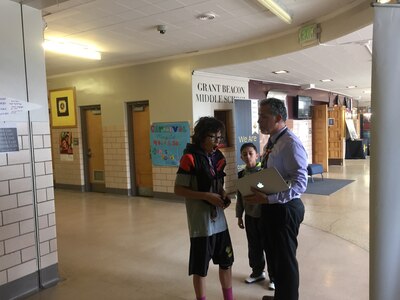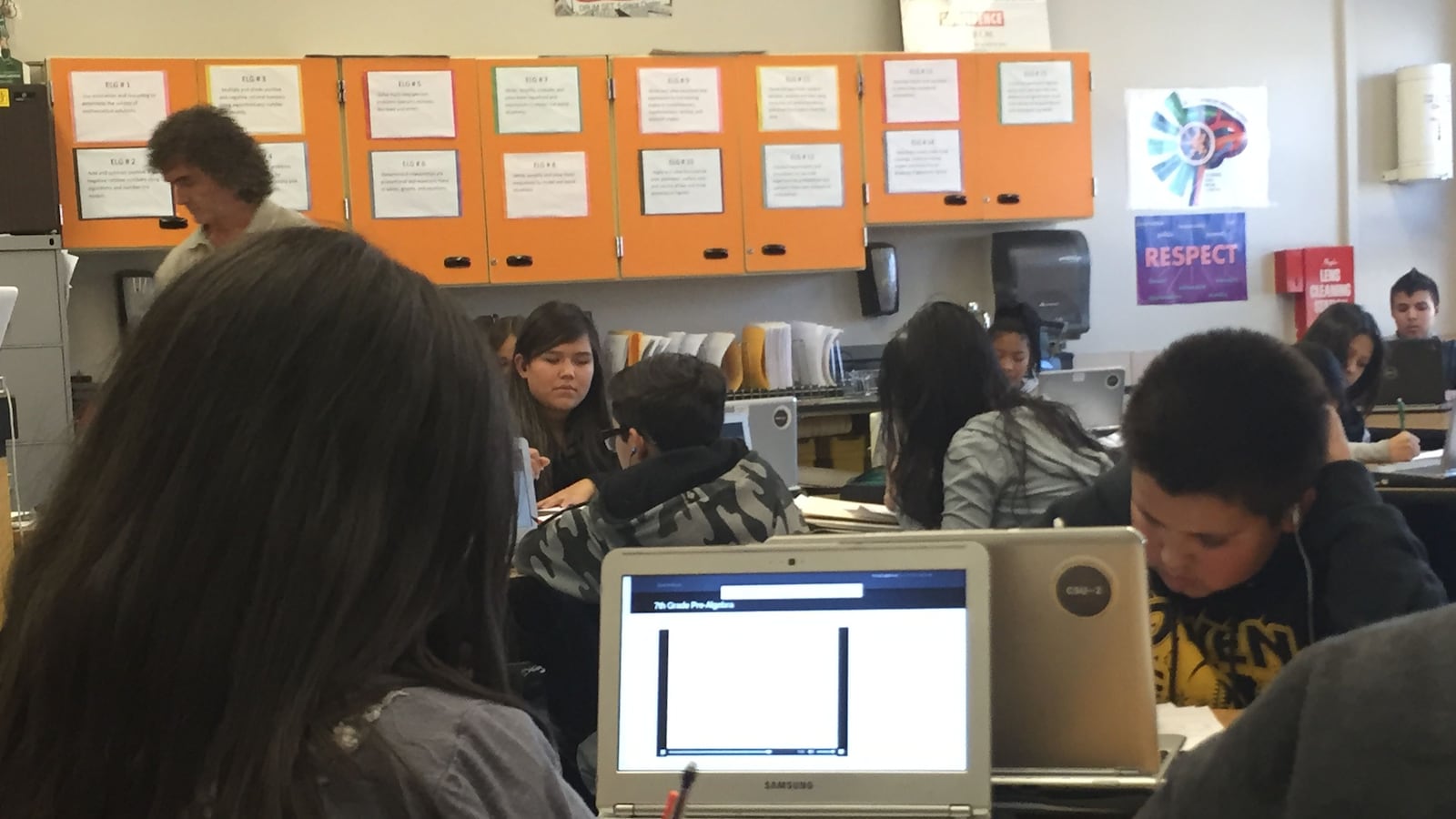What do you do if you’re a school district with a successful principal?
In the case of Alex Magaña, the principal at Grant Beacon Middle School, Denver Public Schools has an idea: Give him two schools.
Starting in 2016-17, Magaña will oversee Grant Beacon and a new district-run innovation school, which will be called Kepner Beacon, at the Kepner Middle School campus in southwest Denver.
As executive principal, Magaña will supervise principals at both Kepner and Grant. A small network staff will include a data specialist and an operations officer responsible for both schools. Teachers at Kepner and Grant will plan and train together.
The schools together will be known as the Beacon Network. Both will be innovation schools, which have flexibility from certain district and state policies, and will focus on blended learning, in which technology is integrated into classroom instruction.
DPS is calling the new arrangement an Innovation Management Organization. The structure and its name are directly cribbed from the charter school world, where charter management organizations run networks of schools.
The hope is that the Innovation Management Organization structure will allow successful principals to expand strong programs without leaving their current schools to crash and burn.
Many DPS principals stay at their schools for only a few years, which leads to instability for staff and students. Magaña says this new arrangement means he will be able to expand the scope of his work while maintaining his ties to the community and programs at Grant Beacon.
“The biggest fear is, if you leave this falls apart. That’s not a good feeling,” Magaña said. “So much has been invested here.”
A template
Beacon is likely the first of several such networks in Denver.
At least one other district school, McAuliffe International School in Park Hill, has already applied to expand and become the city’s second innovation management organization. (McAuliffe principal Kurt Dennis declined a request for an interview.)
Other innovation schools, such as DCIS and Ashley Elementary, might also be candidates for expansion, said Alyssa Whitehead-Bust, Denver’s chief academic and innovation officer.
“It makes sense to do more of what we know already works versus always trying to design from scratch,” Whitehead-Bust said.
Magaña said that the rapid growth of charter school networks in the city made him wonder.
“There’s a demand for effective schools to replicate quite quickly,” Magaña said. “We thought, ‘Why can charter schools replicate so quickly? Why can’t I do that?’…I think we can show public schools are just as effective as charters.”
Bryan Hassel, a co-director of Public Impact, an education policy and management consulting firm in Chapel Hill, N.C, said that the idea of a single principal overseeing several schools is not unique. But, he said, both the idea of using this as a strategy for expanding the reach of successful principals and the charter-inspired name is new.
“Urban areas are desperate for good principals,” he said. “When they find them they often promote them into a central office job where they aren’t really impacting teachers and kids like they are in the principalship. The idea of creating this alternate career path is compelling.”
But there are challenges for principals newly charged with overseeing several schools, Hassel said.
“If you’re over two schools, over three schools, how do you have the time to do them justice?” he said.
Current Grant Beacon staff are optimistic.
“I think that Grant Beacon Middle School is pure magic, and I’ve been here long enough to know what it used to be like and what it’s like now,” said Valerie Svodoba, a teacher leader and language arts teacher at the school. “To be able to take that success and transplant that into a school that really needs it is a beautiful thing.”
Grant Beacon has earned national attention for its blended learning program. It has also moved from the second lowest rating of five on the district’s school performance framework to the second highest during the past eight years. The performance framework evaluates a schools’ academic performance and other characteristics.
The school has also seen a trend toward declining enrollment reverse.
Magaña said that if the Kepner expansion goes as well, the network might eventually add a high school or an elementary school.
New plans, complicated history
In 2016-17, Kepner Beacon will start enrolling students in the Kepner building. The plan is to phase in a grade at a time, starting with sixth graders.
But the new school is opening in a complex environment, as part of an effort to replace the current Kepner Middle School. Kepner, in southwest Denver, was identified as in need of drastic improvements last school year. DPS floated and then retracted several proposals for the school over the course of 2014.
In December, the district put its decision-making on hold yet again to respond to concerns about whether its plans adequately met the needs of the school’s English language learners and the requirements of a court-ordered agreement with the U.S. Department of Justice and the Congress of Hispanic Educators, a group of local Denver Latino educators and parents, that governs how DPS works with Spanish-speaking students.
As part of an effort to meet the requirements of the agreement, Kepner Beacon will have a native-language program for Spanish speakers. Such a program is not in place at Grant Beacon.
The plan the district’s board eventually approved means that in 2016-17, four schools will be running in the Kepner building: the current program that will be in its second-to-last year of being phased out; and two charter schools, Compass Academy and a school run by STRIVE Prep. The school will also be within one of the district’s new shared enrollment zones, in which students are not assigned to a neighborhood school but are given enrollment preference at a cluster of schools.
Magaña said he is approaching the shared space with some trepidation.
“Culture is our number one priority,” he said, and creating that culture in a shared space might prove more challenging.
Kepner Beacon teachers will start work in 2015, a year before the school is scheduled to open. Using school start-up funds earmarked by the district, the network will begin preparing new teachers for Grant Beacon’s blended learning approach and work with English language learners.
Unknowns remain

Magaña said he thinks the model will be more sustainable for the principals at Grant and Kepner, who will have the support of the network team and the executive principal as well as teacher leaders in their schools. He said he envisioned himself spending far more time in each school than the district’s instructional superintendents, who oversee principals across the district.
He said he also thinks the model will be more financially efficient in three years than running two separate schools. That’s because the schools will be able to share some staff and resources.
But just how the Beacon Network team — an extra level of administration — will interact with the rest of the district’s staff is still not yet clear.
“We’re early on in our thinking,” Whitehead-Bust said. “Clearly [Magaña] will report to an instructional superintendent, but he’ll have more autonomy in managing the two building leaders.”
Svodoba, who currently leads Grant Beacon’s data literacy team, said she is interested in working as one of the Beacon network staff.
“There’s a little bit of apprehension about what that will look like,” she said. “The roles aren’t clearly defined yet, so we’re sort of having to invent them as we go.”


